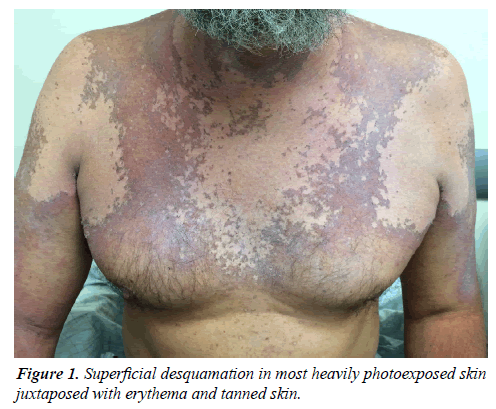Clinical Image - Journal of Dermatology Research and Skin Care (2019) Volume 3, Issue 1
Rovalpituzumab induced photosensitivity
- *Corresponding Author:
- Mathis J
University of Utah Department of Dermatology, North University Avenue, Farmington, USA
Tel: 8012133200
E-mail: Jason.Mathis@hsc.utah.edu
Accepted date: January 22, 2019
Citation: Mathis J (2016) Rovalpituzumab induced photosensitivity. Dermatol Res Skin Care. 2018;2(1):18.
Abstract
Rovalpituzumab is a novel medication with a side effect profile that is not yet widely known. Photosensitivity has been previously reported, and herein I report another case further highlighting these potentially problematic side effects. A 54-year-old male presented for a rash present during the last 1.5 months. He had a history of glioblastoma that had been progressing despite resection, radiotherapy, temozolomide, and veliparib. He was started on Rovelizumab Tsarina, an antibody-drug compound directed against Delta-like protein 3 (DLL3). Three weeks after initiation of the medication, he developed a severe sunburn while on vacation. He had never sunburned previously. His skin blistered, and subsequently peeled. Review of systems was negative, aside from pruritus during peeling. He continued developing some new pink plaques on the upper lateral arms despite returning from vacation over 1 month prior. On exam he had diffuse desquamation over the sun exposed upper chest and shoulders (Figure 1). Chronically photo-hardened areas of the hands, face was spared. ANA was negative.
Clinical Image
Rovalpituzumab is a novel medication with a side effect profile that is not yet widely known. Photosensitivity has been previously reported, and herein I report another case further highlighting these potentially problematic side effects. A 54-year-old male presented for a rash present during the last 1.5 months. He had a history of glioblastoma that had been progressing despite resection, radiotherapy, temozolomide, and veliparib. He was started on Rovelizumab Tsarina, an antibody-drug compound directed against Delta-like protein 3 (DLL3). Three weeks after initiation of the medication, he developed a severe sunburn while on vacation. He had never sunburned previously. His skin blistered, and subsequently peeled. Review of systems was negative, aside from pruritus during peeling. He continued developing some new pink plaques on the upper lateral arms despite returning from vacation over 1 month prior. On exam he had diffuse desquamation over the sun exposed upper chest and shoulders (Figure 1). Chronically photo-hardened areas of the hands, face was spared. ANA was negative.
UVA is responsible for phototoxic and photoallergic reactions and is not blocked by most window glass. Patients on known phototoxic medications therefore must take extra precaution. Differentiation between phototoxic and photoallergic reactions can often be accomplished with clinical history, though histology may be beneficial in difficult cases. Typically, phototoxic reactions arise acutely and predictably with exposure, resemble sunburns visually and symptomatically and are strictly limited to area of exposure. Photoallergic reactions may resemble dermatitis, spread outside the area of sun exposure, arise slightly later, and persist even without ongoing photo exposure. Rovelizumab has been reported one other time to cause a phototoxic reaction, and our patient reported a history consistent with this diagnosis.1 His delayed presentation and ongoing rash suggested photo allergy may have been contributing, but he declined biopsy and photo testing. The clinical teaching point that UVA penetrates window glass may explain his story that the rash continued despite lack of obvious sun exposure. The side effect of photosensitivity (either allergy or toxicity) should be discussed with all patients initiating this medication. Whether this risk will translate into heightened or significant risk for skin cancer remains to be seen and should be carefully monitored for in the future [1,2].
References
- Hou JL, Bridges AG. Phototoxic drug reaction with the novel agent rovalpituzumab tesirine. International Journal of Dermatology. 2018;57(3):17-19.
- Govindan R, Page N, Morgensztern D. Changing epidemiology of small-cell lung cancer in the United States over the last 30 years: analysis of the surveillance, epidemiologic, and end results database. J Clin Oncol. 2006;24(5):4539-4544
